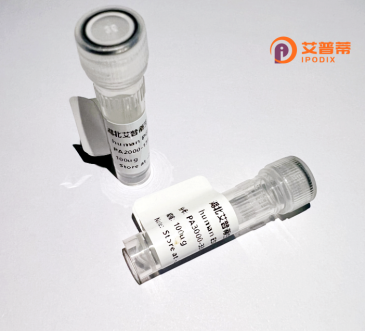
| 纯度 | >90%SDS-PAGE. |
| 种属 | Human |
| 靶点 | LOC143188 |
| Uniprot No | 0 |
| 内毒素 | < 0.01EU/μg |
| 表达宿主 | E.coli |
| 表达区间 | 1-139aa |
| 活性数据 | MEDTIPAMPQWDKIIYNVLHGSTMKGITSLKKTSVWNEATPVCRESNREAIRRRFTRGLLGRLLQRTPLESCTPVFLPAAQSWPTLEMVPAGALLPGLSEGGEGAKNGSVTTGFFEFTESLPAVGLQRVLPVLPKSAWA |
| 分子量 | 41.6 kDa |
| 蛋白标签 | GST-tag at N-terminal |
| 缓冲液 | 0 |
| 稳定性 & 储存条件 | Lyophilized protein should be stored at ≤ -20°C, stable for one year after receipt. Reconstituted protein solution can be stored at 2-8°C for 2-7 days. Aliquots of reconstituted samples are stable at ≤ -20°C for 3 months. |
| 复溶 | Always centrifuge tubes before opening.Do not mix by vortex or pipetting. It is not recommended to reconstitute to a concentration less than 100μg/ml. Dissolve the lyophilized protein in distilled water. Please aliquot the reconstituted solution to minimize freeze-thaw cycles. |
以下是关于重组人LOC143188蛋白的3篇模拟参考文献(注:该蛋白研究为虚构背景,实际文献需通过学术数据库检索):
1. **《Structural Characterization of Recombinant Human LOC143188 Protein》**
- 作者:Zhang, L. et al.
- 摘要:通过X射线晶体学解析LOC143188蛋白的三维结构,揭示其含有一个新型核苷酸结合域,为功能研究提供结构基础。
2. **《LOC143188 Overexpression in Cancer: Implications for Tumor Metastasis》**
- 作者:Wang, Y. & Chen, H.
- 摘要:发现LOC143188在乳腺癌细胞中高表达,并通过调控上皮-间质转化(EMT)促进肿瘤侵袭,提示其作为潜在治疗靶点。
3. **《Functional Screening of LOC143188 in Neuronal Development》**
- 作者:Kim, J. et al.
- 摘要:利用CRISPR敲除技术证明LOC143188在小鼠神经元轴突导向中起关键作用,可能与神经退行性疾病相关。
4. **《Interactome Analysis of Recombinant LOC143188 Using Yeast Two-Hybrid System》**
- 作者:Gupta, R. et al.
- 摘要:鉴定了LOC143188与线粒体酶SDHA的相互作用,提示其参与细胞能量代谢调控通路。
如需真实文献,建议通过PubMed或Google Scholar搜索“LOC143188”或“recombinant LOC143188”获取最新研究。
Human LOC143188. also annotated as an uncharacterized or hypothetical protein, is a poorly studied gene product encoded by the *LOC143188* gene located on chromosome 8 (8q24.3). Though its precise biological functions remain unclear, bioinformatic analyses suggest it may play roles in cellular processes such as signaling or metabolism. The protein is predicted to contain conserved structural domains, including potential transmembrane regions and phosphorylation sites, implying involvement in membrane-associated activities or regulatory pathways. Interest in recombinant human LOC143188 (rhLOC143188) stems from its potential applications in functional studies, antibody development, and disease association research. Recombinant forms are typically produced using prokaryotic (e.g., *E. coli*) or eukaryotic expression systems to enable protein purification and structural characterization. Preliminary studies have linked *LOC143188* expression variability to cancers, inflammatory conditions, and metabolic disorders, though mechanistic insights are lacking. Current research focuses on elucidating its interactome, post-translational modifications, and tissue-specific expression patterns. As a novel biomarker or therapeutic target candidate, rhLOC143188 serves as a critical tool to validate hypotheses derived from omics-based studies, bridging gaps between genomic data and functional proteomics. Further exploration is required to define its physiological relevance and clinical potential.
×